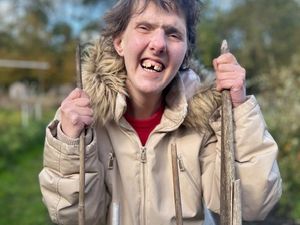Staffies breed in need of new home
Staffordshire bull terriers have been given an unwarranted bad name of late, resulting in a rescue campaign, writes Julia Kaminski.
Staffordshire bull terriers have been given an unwarranted bad name of late, resulting in a rescue campaign,
.
It's a grey, February day in mid-Shropshire, and 50 excited dogs are trying to attract my attention, all desperate for a walk. These are the residents of Hilbrae Kennels, one of several hundred dog rescue centres throughout the UK.
You know you can't walk them all - there isn't time - and it's so hard to choose. They all have big brown eyes and waggy tails. And the question you have to ask is, why are they here?
They don't look mean; just friendly, and eager to have some fun. As you read the descriptions above their kennels - "very good on a lead, but doesn't like cats", "good with children, a bit shy at first", "very friendly, but can't be left alone all day" - it dawns on you that these dogs are probably asking themselves the same question: 'Why am I here?'
But this isn't just about the sheer number of dogs who find themselves in rescue every year: nearly 8,000 at Battersea Dogs' Home, in London, alone. It's about the particular problem of Staffies.
Rescue centres around the country are inundated with Staffies, or Staffie crosses. Staffordshire bull terriers, as they are properly known, make up between 50 and 75 per cent of all unwanted dogs. At Battersea, 43 per cent of all dogs taken in during 2009 were Staffies.
At Birmingham Dogs' Home last year, it was 40 per cent. At Roden in Shropshire, they rehomed 104 Staffie crosses last year. At Hilbrae, 60 per cent of their dogs are Staffies.
In the past week alone, it has taken in 22. It is also having to turn some away, because the kennels are full.
"We're turning away two or three Staffies a day," says Marty Burrell, the owner. "Of the last 20 calls from people wanting us to take a dog for them, 15 have been Staffies. The problem is much worse than even a couple of years ago, and getting worse all the time."
And what will happen to those she has to turn away? "Well, the risk is that they'll be dumped."
But why? Traditionally known as "the nanny dog", Staffies were considered a good family dog because they are so good with children.
"They like to play, they're clowns," says Marty. The trouble is, of late that reputation has been changing. Staffies have become the dog of choice for young men who want a "status dog".
They are often cross-bred to try to give them the desired characteristics: ferocity and meanness. Staffies already have a stocky build and strong jaw, but this belies a gentle nature, totally unsuited to fighting or attacking people. Cross them with other breeds, however, and it can be a different story.
Marty says: "These crosses have two completely different characteristics driving them. You don't always know what they're crossed with, and you can't be sure of their temperament."
This is not to say that these dogs are ill-tempered or unrehomeable. Most are desperate for affection and very well-behaved. One or two sit patiently while I put a lead on them, others jump about excitedly, but walk beautifully on the lead. All of them are happy to be out in the fresh air.
The tragedy is that people are breeding them to make money - they can sell for anything from £250 up to £700 - but there aren't nearly enough homes for all of them, so they end up in rescue.
The RSPCA has begun a campaign, SOS - Save Our Staffies - to highlight the problem. Up to 80 per cent of dogs in their rescue centres, too, are Staffies. They have launched an awareness video that shows what wonderful family dogs they can be.
Louise Campbell, manager of Dogs Trust Roden, says: "Staffies are victims of their reputation. They have become a status symbol, but high numbers are ending up in rescue."
Like Dogs Trust, Hilbrae has a policy of never putting to sleep a healthy animal, so dogs may spend years here before finding a home. But these are the lucky ones. Healthy Staffies in other parts of the country are being put to sleep in huge, increasing numbers.
Last August, a Panorama team visited Battersea to find out the scale of the problem and how they are dealing with it. Of the almost 8,000 dogs who came through Battersea's doors in 2009, almost 3,000 of them were put to sleep.
Charlotte Walsh, communications officer at Battersea, points out that the home has an open-intake policy. Battersea says: "We accept dogs that often simply have nowhere else to go" unlike some rescue centres, which are more selective.
As a consequence, Battersea's figures appear worse than those of other dogs' homes. "I think it's a great shame," says Marty at Hilbrae, "but I understand that they don't have a choice."
At the root of the problem are what Marty calls the "back-yard breeders", who may just let their Staffie bitch have one or two litters, but when there are not even enough homes for these puppies, rescue is the best they can hope for. Last Christmas, a litter of puppies was found dumped in a box and brought to Hilbrae. These all found new homes, but some are not so lucky.
Vets Now, the emergency vet chain, was recently asked to put to sleep healthy puppies because homes could not be found for them.
Without a law forcing people to have a licence for their dog, or microchip it, there is no way of cracking down on unlicensed breeders.
But even licensed ones are adding to the problem. A Google search on "staffie breeders" produces 603,000 results. They just keep on breeding them, even though there are too many already.
Quite simply, the situation is a national disgrace.
Is there a solution? "I think it all comes down to education," says Marty at Hilbrae. "I'd like to see all breeders licensed. A moratorium on breeding Staffies for five years would be fantastic. But I can't see it happening."
All the rescue centres concur, but so far the government has done nothing.
Vets could help by reducing the cost of neutering, or the government could subsidise it - but in these days of cuts to vital public services, this looks extremely unlikely.
The only potential solutions are enforced neutering, a licence, or compulsory microchipping. These may not guarantee a 100 per cent success rate, because there will always be people who break the law. But shouldn't we at least try, to give the dogs on death row a chance at life?





